Scenario Analysis of Carbon Emissions in the Energy Base, Xinjiang Autonomous Region, China
Abstract
1. Introduction
2. Study Area
3. Data and Method
3.1. Data Sources
3.2. Calculation of Carbon Emissions
3.3. STIRPAT Model
3.4. Environmental Kuznets Curve (EKC)
3.5. Ridge Regression
4. Empirical Analysis
4.1. Features and Trajectories of Carbon Emissions and Influencing Factors
4.2. Unit Root Test and Conintegration Test
4.3. Ridge Regression Estimation
4.4. Model Verification
5. Scenario Analysis
5.1. Scenarios Construction
5.2. The Projection of Carbon Emissions
6. Discussion
7. Conclusions and Policy Implications
Author Contributions
Acknowledgments
Conflicts of Interest
Nomenclature
| IPCC | Intergovernmental Panel on Climate Change |
| AR5 | Fifth Assessment Report (AR5) |
| USA | United States of America |
| STIRPAT | Stochastic Impacts by Regression on Population, Affluence and Technology |
| EKC | Environmental Kuznets Curve |
| IAMs | Integrated Assessment Model |
| LEAP | Long-range Energy Alternative Planning |
| GM | Grey Model |
| GDP | Gross domestic product |
| CEAD | China Emission Accounts and Datasets |
| CPI | Consumer Price Index |
| OLS | ordinary least square |
| VIF | variance inflation factor |
| IPAT | Impact = Population × Affluence × Technology |
| I | carbon emissions |
| P | population |
| A | GDP per capita |
| T | energy intensity |
| E | energy consumption structure |
| U | urbanization rate |
| S | industrial structure |
| EEIA | elasticity of GDP per capita |
| SPSS | Statistical Product and Service Solutions |
| IIASA | International Institute for Applied Systems Analysis |
| ADF | Augmented Dickey-Fuller |
| NDC | National Determined Contribution |
References
- IPCC. Climate Change 2013: The Physical Science Basis; Cambridge University Press: Cambridge, MA, USA; New York, NY, USA, 2013. [Google Scholar]
- Shuai, C.; Shen, L.; Jiao, L.; Wu, Y.; Tan, Y. Identifying key impact factors on carbon emission: Evidences from panel and time-series data of 125 countries from 1990 to 2011. Appl. Energy 2017, 187, 310–325. [Google Scholar] [CrossRef]
- Gasbarro, F.; Iraldo, F.; Daddi, T. The drivers of multinational enterprises′ climate change strategies: A quantitative study on climate-related risks and opportunities. J. Clean. Prod. 2017, 160, 8–26. [Google Scholar] [CrossRef]
- Liu, D.; Xiao, B. Can China achieve its carbon emission peaking? A scenario analysis based on STIRPAT and system dynamics model. Ecol. Indic. 2018, 93, 647–657. [Google Scholar] [CrossRef]
- Wang, C.J.; Wang, F. Examining the driving factors of energy related carbon emissions using the extended STIRPAT model based on IPAT identity in Xinjiang. Renew. Sustain. Energy Rev. 2017, 67, 51–61. [Google Scholar] [CrossRef]
- Wu, C.B.; Huang, G.H.; Liu, Z.P.; Zhen, J.L.; Yin, J.G. Scenario analysis of carbon emissions’ anti-driving effect on Qingdao′s energy structure adjustment with an optimization model, Part II: Energy system planning and management. J. Environ. Manag. 2017, 188, 120–136. [Google Scholar] [CrossRef]
- Liu, Z.; Guan, D.; Wei, W.; Davis, S.J.; Ciais, P.; Bai, J.; Peng, S.; Zhang, Q.; Hubacek, K.; Marland, G. Reduced carbon emission estimates from fossil fuel combustion and cement production in China. Nature 2015, 524, 335. [Google Scholar] [CrossRef] [PubMed]
- Shan, Y.; Guan, D.; Liu, J.; Mi, Z.; Liu, Z.; Liu, J.; Schroeder, H.; Cai, B.; Chen, Y.; Shao, S. Methodology and applications of city level CO2 emission accounts in China. J. Clean. Prod. 2017, 161, 1215–1225. [Google Scholar] [CrossRef]
- Shan, Y.; Guan, D.; Zheng, H.; Ou, J.; Li, Y.; Meng, J.; Mi, Z.; Liu, Z.; Zhang, Q. China CO2 emission accounts 1997–2015. Sci. Data 2018, 5, 170201. [Google Scholar] [CrossRef]
- Wu, R.; Dong, J.; Zhou, L.; Zhang, L. Regional Distribution of Carbon Intensity and its Driving Factors in China: An Empirical Study Based on Provincial Data. Pol. J. Environ. Stud. 2018, 27. [Google Scholar] [CrossRef]
- Zhang, P.; He, J.; Hong, X.; Zhang, W.; Qin, C.; Pang, B.; Li, Y.; Liu, Y. Regional-Level Carbon Emissions Modelling and Scenario Analysis: A STIRPAT Case Study in Henan Province, China. Sustainability 2017, 9, 2342. [Google Scholar] [CrossRef]
- Liu, Y.; Lei, W. The Peak Value of Carbon Emissions in the Beijing-Tianjin-Hebei Region Based on the STIRPAT Model and Scenario Design. Pol. J. Environ. Stud. 2016, 25. [Google Scholar] [CrossRef]
- Wang, M.; Yue, C.; Kai, Y.; Min, W.; Xiong, L.; Huang, Y. A local-scale low-carbon plan based on the STIRPAT model and the scenario method: The case of Minhang District, Shanghai, China. Energy Policy 2011, 39, 6981–6990. [Google Scholar] [CrossRef]
- Wu, J.; Mohamed, R.; Wang, Z. An Agent-Based Model to Project China’s Energy Consumption and Carbon Emission Peaks at Multiple Levels. Sustainability 2017, 9, 893. [Google Scholar] [CrossRef]
- Zheng, T.; Zhu, J.; Wang, S.; Fang, J. When will China achieve its carbon emission peak? Natl. Sci. Rev. 2016, 3, 8–12. [Google Scholar] [CrossRef]
- Wang, C.J.; Zhang, X.L.; Wang, F. Decomposition of energy-related carbon emissions in Xinjiang and relative mitigation policy recommendations. Front. Earth. Sci. 2015, 9, 65–76. [Google Scholar] [CrossRef]
- Liu, Z.; Guan, D.; Crawfordbrown, D.; Zhang, Q.; He, K.; Liu, J. Energy policy: A low-carbon road map for China. Nature 2013, 500, 143. [Google Scholar] [CrossRef]
- Jin, W. Can technological innovation help China take on its climate responsibility? An intertemporal general equilibrium analysis. Cama Work. Pap. 2012, 49, 629–641. [Google Scholar] [CrossRef]
- Shi, A. The impact of population pressure on global carbon dioxide emissions, 1975–1996: Evidence from pooled cross-country data. Ecol. Econ. 2004, 44, 29–42. [Google Scholar] [CrossRef]
- Cole, M.A.; Neumayer, E. Examining the Impact of Demographic Factors on Air Pollution. Populat. Environ. 2004, 26, 5–21. [Google Scholar] [CrossRef]
- Martínezzarzoso, I.; Bengochea-Morancho, A.; Moraleslage, R. The impact of population on CO2 emissions: Evidence from European countries. Environ. Resour. Econ. 2007, 38, 497–512. [Google Scholar] [CrossRef]
- Maruotti, A. The impact of urbanization on CO2 emissions: Evidence from developing countries. Ecol. Econ. 2011, 70, 1344–1353. [Google Scholar]
- Saidi, K.; Mbarek, M.B. The impact of income, trade, urbanization, and financial development on CO2 emissions in 19 emerging economies. Environ. Sci. Pollut. Res. Int. 2017, 24, 12748–12757. [Google Scholar] [CrossRef]
- Al-Mulali, U.; Che, N.B.C.S. The impact of energy consumption and CO2 emission on the economic and financial development in 19 selected countries. Renew. Sustain. Energ. Rev. 2012, 16, 4365–4369. [Google Scholar] [CrossRef]
- Chang, L.; Mu, H.L.; Li, H.N. Decomposition of Energy-Related CO2 Emission over 2001 and 2011 in Manufacturing Industry of China. Adv. Mater. Res. 2017, 190, 772–787. [Google Scholar]
- Zheng, Y.; Luo, D. Industrial structure and oil consumption growth path of China: Empirical evidence. Energy 2013, 57, 336–343. [Google Scholar] [CrossRef]
- Li, K.; Lin, B. The improvement gap in energy intensity: Analysis of China’s thirty provincial regions using the improved DEA (data envelopment analysis) model. Energy 2015, 84, 589–599. [Google Scholar] [CrossRef]
- Shao, S.; Yang, L.; Gan, C.; Cao, J.; Geng, Y.; Guan, D. Using an extended LMDI model to explore techno-economic drivers of energy-related industrial CO2 emission changes: A case study for Shanghai (China). Renew. Sustain. Energy Rev. 2016, 55, 516–536. [Google Scholar] [CrossRef]
- Wu, C.B.; Huang, G.H.; Xin, B.G.; Chen, J.K. Scenario analysis of carbon emissions′ anti-driving effect on Qingdao′s energy structure adjustment with an optimization model, Part I: Carbon emissions peak value prediction. J. Clean. Prod. 2018, 172, 466–474. [Google Scholar] [CrossRef]
- Diao, X.D.; Zeng, S.X.; Tam, C.M.; Tam, V.W.Y. EKC analysis for studying economic growth and environmental quality: A case study in China. J. Clean. Prod. 2009, 17, 541–548. [Google Scholar] [CrossRef]
- Marangoni, G.; Tavoni, M.; Bosetti, V.; Borgonovo, E.; Capros, P.; Fricko, O.; Gernaat, D.E.H.J.; Guivarch, C.; Havlik, P.; Huppmann, D. Sensitivity of projected long-term CO2 emissions across the Shared Socioeconomic Pathways. Nat. Clim. Chang. 2017, 7, 113–117. [Google Scholar] [CrossRef]
- Tao, Z.; Zhao, L.; Zhao, C. Research on the prospects of low-carbon economic development in China based on LEAP model. Energy Procedia 2011, 5, 695–699. [Google Scholar] [CrossRef]
- Wang, Z.X.; Ye, D.J. Forecasting Chinese carbon emissions from fossil energy consumption using non-linear grey multivariable models. J. Clean. Prod. 2017, 142, 600–612. [Google Scholar] [CrossRef]
- Tollefson, J. China’s carbon emissions could peak sooner than forecast. Nature 2016, 531, 425. [Google Scholar] [CrossRef]
- Jiang, J.; Ye, B.; Xie, D.; Tang, J. Provincial-level carbon emission drivers and emission reduction strategies in China: Combining multi-layer LMDI decomposition with hierarchical clustering. J. Clean. Prod. 2017, 169, 178–190. [Google Scholar] [CrossRef]
- Wang, Y.; Zhao, T. Impacts of energy-related CO2 emissions: Evidence from under developed, developing and highly developed regions in China. Ecol. Indic. 2015, 50, 186–195. [Google Scholar] [CrossRef]
- Liu, L.C.; Liang, Q.M.; Wang, Q. Accounting for China’s regional carbon emissions in 2002 and 2007: Production-based versus consumption-based principles. J. Clean. Prod. 2015, 103, 384–392. [Google Scholar] [CrossRef]
- Wang, H.K.; Zhang, Y.X.; Lu, X.; Nielsen, C.P.; Bi, J. Understanding China’s carbon dioxide emissions from both production and consumption perspectives. Renew. Sustain. Energy Rev. 2015, 52, 189–200. [Google Scholar] [CrossRef]
- Cong, J.; Kang, W.; Qin, L.; Zhang, Y.; Wang, X.; Liu, Q. Research on Shanxi′s CO2 Emissions Peak Based on STIRPAT Model. In Proceedings of the 2nd International Conference on Judicial, Administrative and Humanitarian Problems of State Structures and Economic Subjects, Moscow, Russia, 21 September 2017; Volume 159, pp. 283–288. [Google Scholar]
- Wang, C.; Wang, F. Structural Decomposition Analysis of Carbon Emissions and Policy Recommendations for Energy Sustainability in Xinjiang. Sustainability 2015, 7, 7548–7567. [Google Scholar] [CrossRef]
- Guo, B.; Yong, G.; Dong, H.; Liu, Y. Energy-related greenhouse gas emission features in China’s energy supply region: The case of Xinjiang. Renew. Sustain. Energy Rev. 2016, 54, 15–24. [Google Scholar] [CrossRef]
- Zhang, L.; Lei, J.; Zhou, X.; Zhang, X.L.; Dong, W.; Yang, Y. Changes in carbon dioxide emissions and LMDI-based impact factor decomposition: The Xinjiang Uygur autonomous region as a case. J. Arid. Land 2014, 6, 145–155. [Google Scholar] [CrossRef]
- Tao, H.; Fischer, T.; Su, B.; Mao, W.; Jiang, T.; Fraedrich, K. Observed changes in maximum and minimum temperatures in Xinjiang autonomous region, China. Int. J. Clim. 2017, 37, 5120–5128. [Google Scholar] [CrossRef]
- Qi, H.; Li, I.; Chen, Y.; Shen, Y.; Xingong, L.I.; Jian, X.U. Spatial and temporal trends of climate change in Xinjiang, China. J. Geogr. Sci. 2011, 21, 1007–1018. [Google Scholar]
- Xinjiang Bureau of Statistics. Xinjiang Statistical Yearbook; Peking Info Press: Beijing, China, 1991–2017. (In Chinese)
- Jiang, T.; Zhao, J.; Cao, L.G.; Wang, Y.J.; Su, B.D.; Jing, C.; Wang, R.; Gao, C. Projection of national and provincial economy under the shared socioeconomic pathways in China. Clim. Chang. Res. 2017, 13, 128–137. (In Chinese) [Google Scholar]
- Jiang, T.; Zhao, J.; Jing, C.; Cao, L.G.; Wang, Y.J.; Sun, H.M.; Wang, A.Q.; Huang, J.L.; Su, B.D.; Wang, R. National and Provincial Population Projected to 2100 Under the Shared Socioeconomic Pathways in China. Clim. Chang. Res. 2018, 14, 50–58. (In Chinese) [Google Scholar]
- Ehrlich, P.R.; Holdren, J.P. Impact of population growth. Science 1971, 171, 1212–1217. [Google Scholar] [CrossRef]
- Holdren, J.P.; Ehrlich, P.R. Human population and the global environment. Am. Sci. 1974, 62, 282. [Google Scholar]
- Feng, K.; Hubacek, K.; Guan, D. Lifestyles, technology and CO2 emissions in China: A regional comparative analysis. Ecol. Econ. 2009, 69, 145–154. [Google Scholar] [CrossRef]
- Li, K.; Lin, B. Impacts of urbanization and industrialization on energy consumption/CO2 emissions: Does the level of development matter? Renew. Sustain. Energy Rev. 2015, 52, 1107–1122. [Google Scholar] [CrossRef]
- Zhang, C.; Lin, Y. Panel estimation for urbanization, energy consumption and CO2 emissions: A regional analysis in China. Energy Policy 2012, 49, 488–498. [Google Scholar] [CrossRef]
- Dietz, T.; Rosa, E.A. Rethinking the environmental impacts of population, Affluence and technology. Hum. Ecol. Rev. 1994, 1, 277–300. [Google Scholar]
- Wang, Z.; Yin, F.; Zhang, Y.; Zhang, X. An empirical research on the influencing factors of regional CO2 emissions: Evidence from Beijing city, China. Appl. Energy. 2012, 100, 277–284. [Google Scholar] [CrossRef]
- Wang, P.; Wu, W.; Zhu, B.; Wei, Y. Examining the impact factors of energy-related CO2 emissions using the STIRPAT model in Guangdong Province, China. Appl. Energy. 2013, 106, 65–71. [Google Scholar] [CrossRef]
- Grossman, G.M.; Krueger, A.B. Environmental Impacts of a North American Free Trade Agreement. Soc. Sci. Electron. Publ. 1991, 8, 223–250. [Google Scholar]
- Wang, W.Y.; Wang, J.; Guo, F. Carbon Dioxide (CO2) Emission Reduction Potential in East and South Coastal China: Scenario Analysis Based on STIRPAT. Sustainability 2018, 10, 1836. [Google Scholar] [CrossRef]
- Hoerl, A.E.; Kennard, R.W. Ridge Regression: Biased Estimation for Nonorthogonal Problems. Technometrics 1970, 12, 55–67. [Google Scholar] [CrossRef]
- MacKinnon, J.G. Numerical distribution functions for unit root and cointegration tests. J. Appl. Econom. 1996, 11, 601–618. [Google Scholar] [CrossRef]
- Ssali, M.W.; Du, J.G.; Mensah, I.A.; Hongo, D.O. Investigating the nexus among environmental pollution, economic growth, energy use, and foreign direct investment in 6 selected sub-Saharan African countries. Environ. Sci. Pollut. Res. 2019, 26, 11245–11260. [Google Scholar] [CrossRef]
- Cao, Y.L.; Mohiuddin, M. Sustainable Emerging Country Agro-Food Supply Chains: Fresh Vegetable Price Formation Mechanisms in Rural China. Sustainability 2019, 11, 2814. [Google Scholar] [CrossRef]
- Yan, Y.X.; Zhao, G.Y. The empirical study on price discovery of cornstarch futures market in China. Appl. Econ. Lett. 2018, 26, 1100–1103. [Google Scholar] [CrossRef]
- Wang, Y.; Han, R.; Kubota, J. Is there an Environmental Kuznets Curve for SO2 emissions? A semi-parametric panel data analysis for China. Renew. Sustain. Energy Rev. 2016, 54, 1182–1188. [Google Scholar] [CrossRef]
- Jiang, L.; O’Neill, B.C. Global urbanization projections for the Shared Socioeconomic Pathways. Glob. Environ. Chang. 2017, 42, 193–199. [Google Scholar] [CrossRef]
- Dai, Y.D.; Kang, Y.B.; Xiong, X.P. 2050 China’s Energy and Carbon Emissions Scenario and Energy Transformation and Low Carbon Development Route Map; China Environment Press: Beijing, China, 2017. (In Chinese) [Google Scholar]
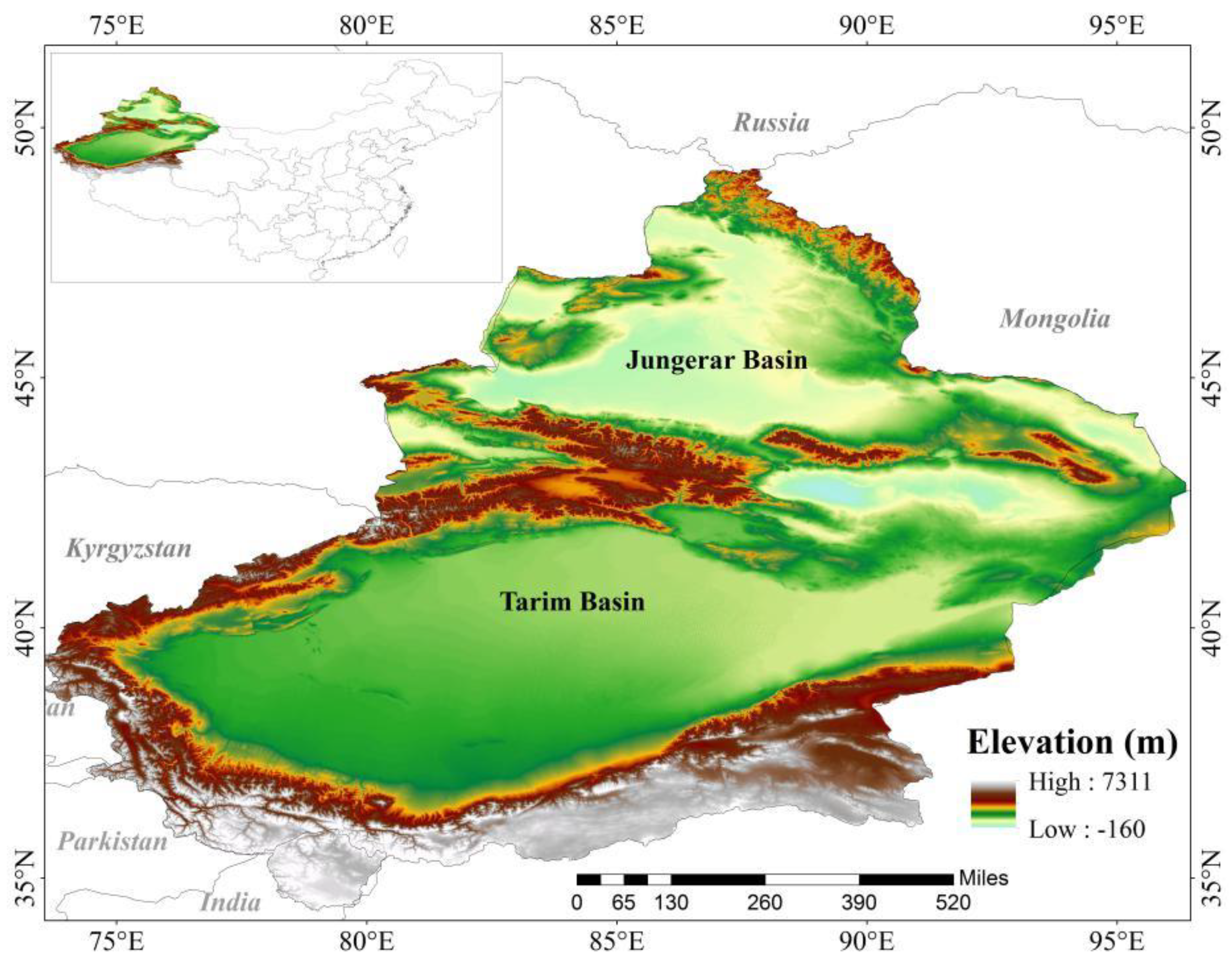

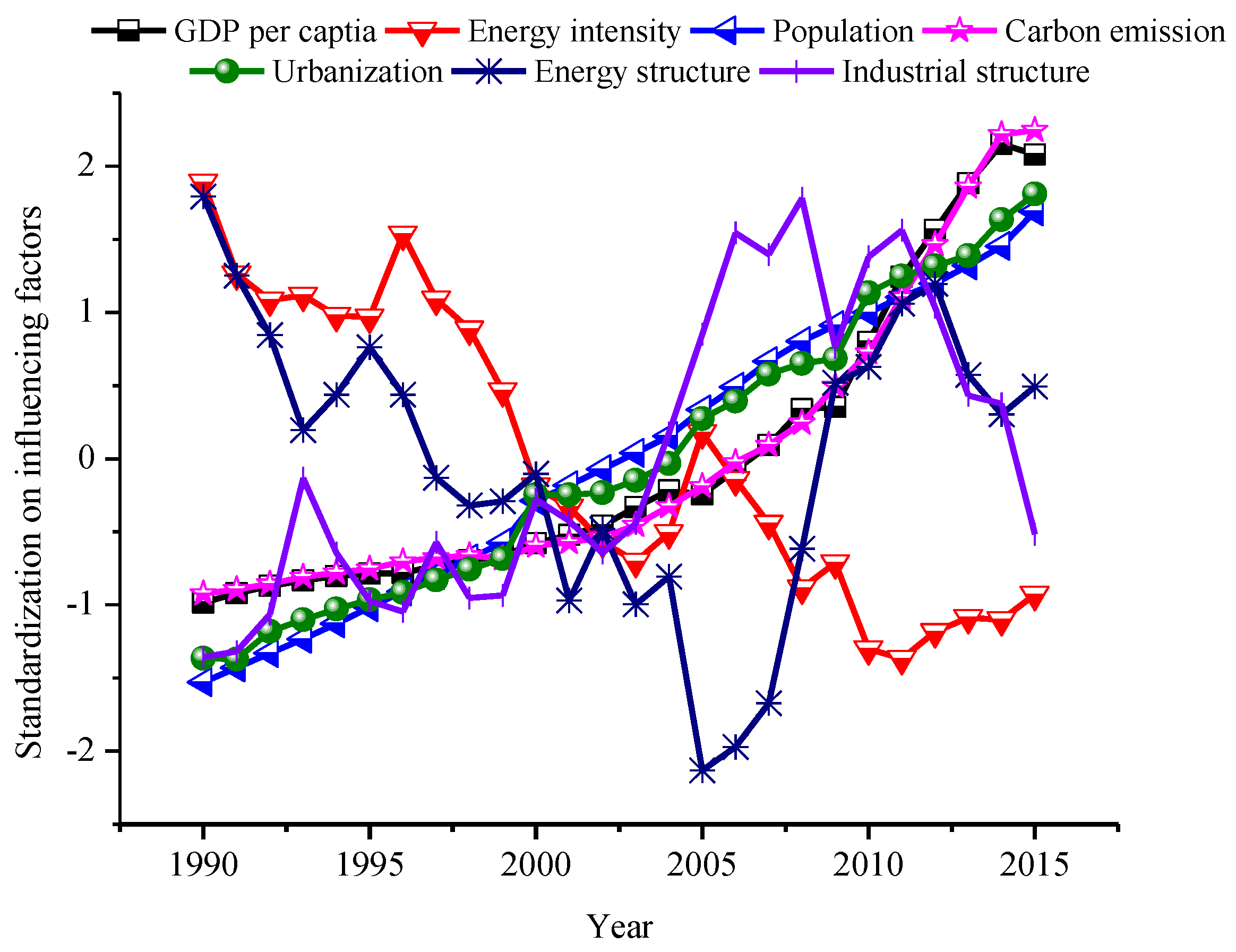
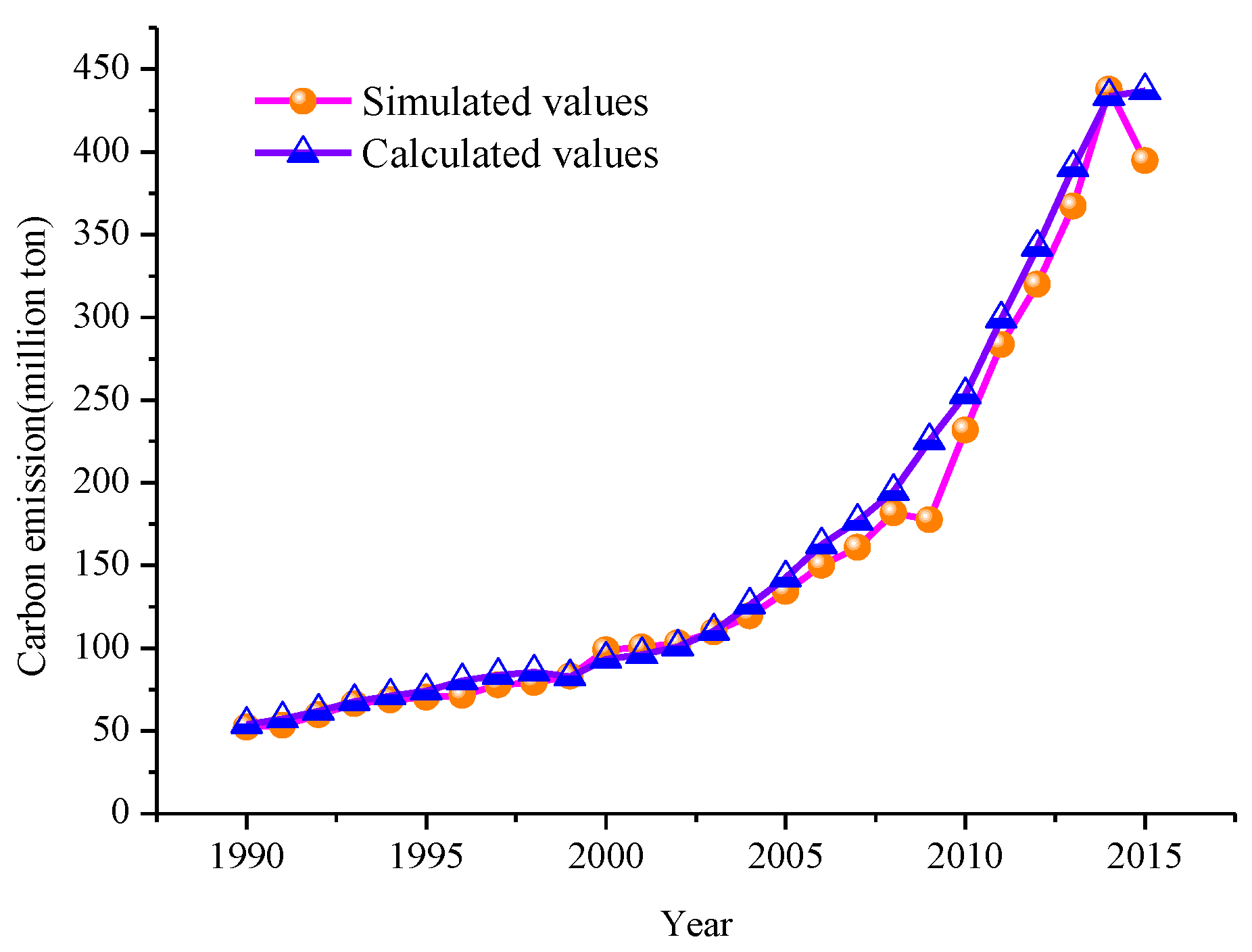
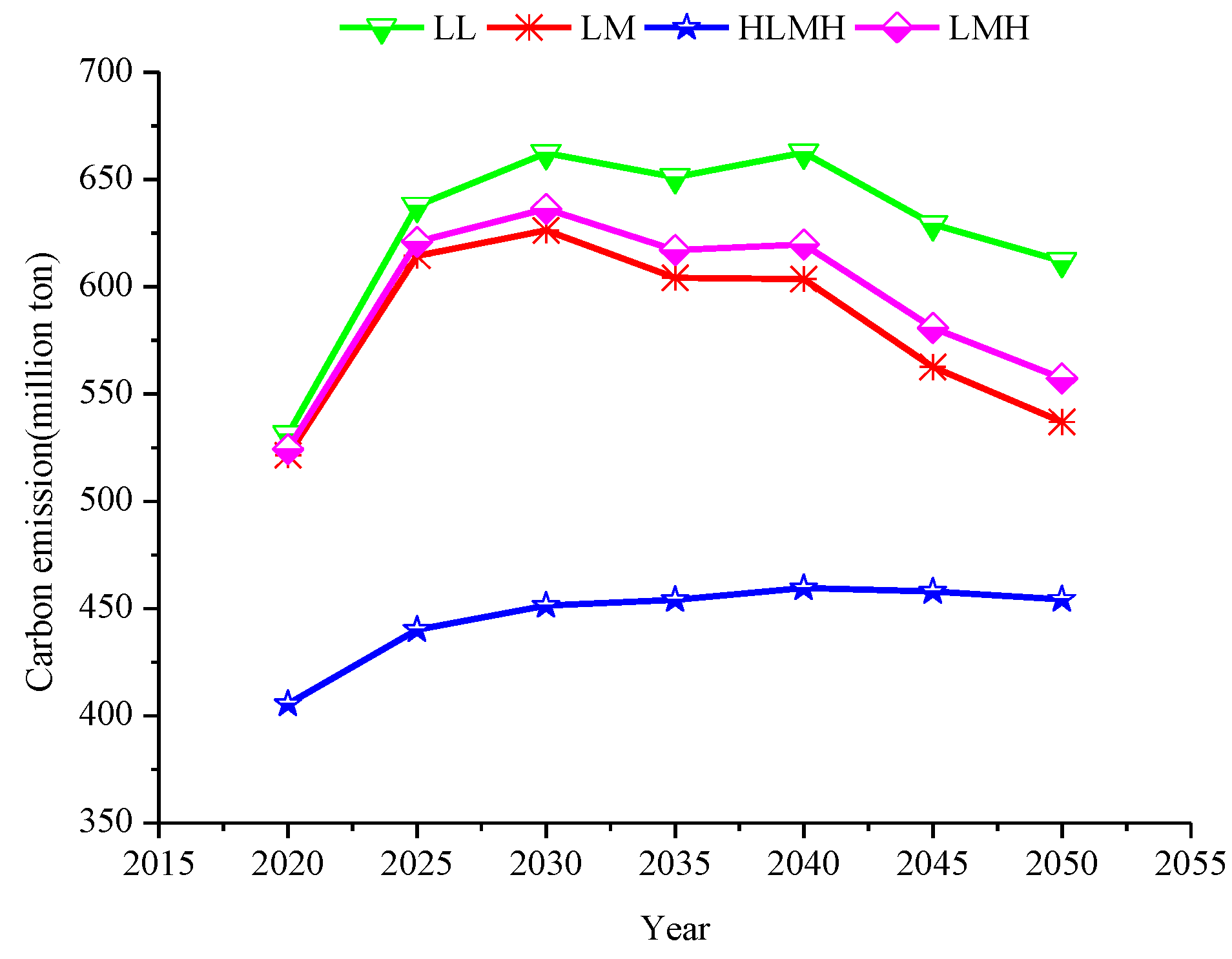
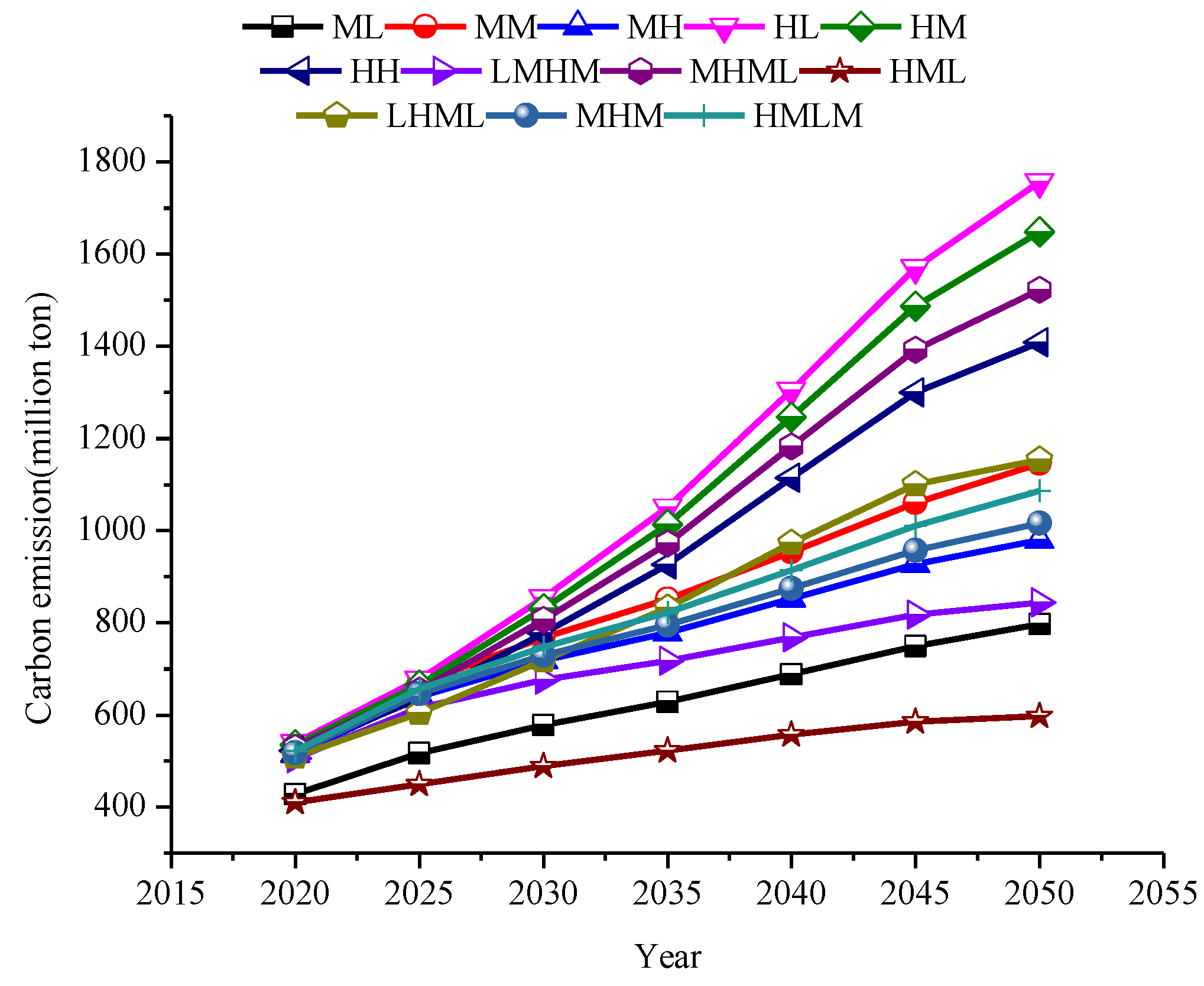
| ADF | Test Critical Values (1%) | Prob. * | |
|---|---|---|---|
| LnI | −6.79 | −4.42 | 0.00 |
| LnP | −7.70 | −4.42 | 0.00 |
| LnA | −7.04 | −4.42 | 0.00 |
| (LnA)2 | −5.31 | −4.42 | 0.00 |
| LnT | −7.65 | −4.44 | 0.00 |
| LnE | −8.63 | −4.42 | 0.00 |
| LnU | −8.41 | −4.50 | 0.00 |
| LnS | −6.60 | −4.47 | 0.00 |
| B | SE | T | Sig | VIF | |
|---|---|---|---|---|---|
| LnP | 1.96 | 1.53 | 1.28 | 0.22 | 324.31 |
| LnA | −0.20 | 0.50 | −0.41 | 0.69 | 669.89 |
| LnA2 | 0.36 | 0.14 | 2.55 | 0.02 | 220.14 |
| LnT | −0.31 | 0.14 | −2.19 | 0.05 | 40.55 |
| LnE | 0.29 | 0.36 | 0.81 | 0.43 | 14.88 |
| LnU | −1.37 | 0.93 | −1.47 | 0.17 | 197.12 |
| LnS | 0.45 | 0.27 | 1.65 | 0.12 | 14.32 |
| Constant | 7.68 | 1.59 | 4.84 | 0.00 |
| B | SE(B) | Beta | T | Sig | |
|---|---|---|---|---|---|
| LnP | 0.80 | 0.05 | 0.20 | 14.14 | 0.00 |
| LnA | 0.19 | 0.01 | 0.21 | 18.07 | 0.00 |
| LnA2 | 0.28 | 0.04 | 0.14 | 5.77 | 0.00 |
| LnT | −0.20 | 0.02 | −0.19 | −8.85 | 0.00 |
| LnE | 0.07 | 0.21 | 0.01 | 0.33 | 0.74 |
| LnU | 0.58 | 0.04 | 0.18 | 14.05 | 0.00 |
| LnS | 0.47 | 0.10 | 0.14 | 4.61 | 0.00 |
| Constant | −0.72 | 1.11 | 0.00 | −0.64 | 0.52 |
| A | 10,000 | 15,000 | 20,000 | 25,000 | 30,000 | 35,000 | 40,000 | 45,000 | 50,000 | 55,000 | 60,000 | 65,000 | 70,000 |
| EEIA | 5.44 | 5.67 | 5.84 | 5.96 | 6.07 | 6.16 | 6.23 | 6.30 | 6.36 | 6.41 | 6.46 | 6.51 | 6.55 |
| ΔEEIA | 0.23 | 0.16 | 0.12 | 0.10 | 0.08 | 0.07 | 0.06 | 0.06 | 0.05 | 0.05 | 0.04 | 0.04 |
| Growth Rate | Time | |||||||
|---|---|---|---|---|---|---|---|---|
| 2020 | 2025 | 2030 | 2035 | 2040 | 2045 | 2050 | ||
| Population (P)/ (million person) | Low | 23.92 | 24.80 | 25.44 | 25.96 | 26.39 | 26.66 | 26.75 |
| Medium | 23.94 | 24.86 | 25.55 | 26.16 | 26.69 | 27.08 | 27.32 | |
| High | 24.07 | 25.15 | 26.05 | 26.88 | 27.67 | 28.35 | 28.93 | |
| GDP per capita (A)/ (ten thousand Yuan/Per person) | Low | 4.51 | 5.55 | 5.71 | 5.63 | 5.73 | 5.52 | 5.46 |
| Medium | 4.65 | 5.62 | 6.50 | 7.05 | 7.70 | 8.38 | 8.93 | |
| High | 4.68 | 5.64 | 6.67 | 7.67 | 8.82 | 9.89 | 10.54 | |
| Urbanization level (U)/% | Low | 48.33 | 49.45 | 50.60 | 51.77 | 52.97 | 54.20 | 55.46 |
| Medium | 49.52 | 51.91 | 54.43 | 57.06 | 59.82 | 62.72 | 65.76 | |
| High | 50.38 | 53.74 | 57.33 | 61.15 | 65.23 | 69.58 | 74.22 | |
| Industrial level (S)/% | Low | 38.22 | 37.83 | 37.46 | 37.08 | 36.72 | 36.35 | 35.99 |
| Medium | 37.83 | 37.08 | 36.35 | 35.63 | 34.92 | 34.23 | 33.55 | |
| High | 37.46 | 36.35 | 35.27 | 34.22 | 33.21 | 32.22 | 31.27 | |
| Energy intensity (T)/ (ton/ten thousand Yuan) | Low | 1.52 | 1.37 | 1.24 | 1.12 | 1.01 | 0.92 | 0.83 |
| Medium | 1.43 | 1.22 | 1.05 | 0.89 | 0.76 | 0.65 | 0.56 | |
| High | 1.28 | 0.97 | 0.74 | 0.56 | 0.43 | 0.33 | 0.25 | |
| Energy structure (E)/% | Low | 61.63 | 57.73 | 54.07 | 50.65 | 47.44 | 44.44 | 41.62 |
| Medium | 59.48 | 53.76 | 48.60 | 43.93 | 39.71 | 35.89 | 32.44 | |
| High | 56.21 | 48.02 | 41.03 | 35.05 | 29.94 | 25.58 | 21.86 | |
| Scenarios | Positive Factors | Negative Factors | ||||
|---|---|---|---|---|---|---|
| Population (P) | GDP Per Capita (A) | Urbanization Level (U) | Energy Intensity (T) | Energy Structure (E) | Industrial Structure (S) | |
| L-L | Low | Low | Low | Low | Low | Low |
| L-M | Low | Low | Low | Medium | Medium | Medium |
| M-L | High | High | Medium | Low | Low | Low |
| M-M | Medium | Medium | Medium | Medium | Medium | Medium |
| M-H | Medium | Medium | Medium | High | High | High |
| H-L | High | High | High | Low | Low | Low |
| H-M | High | High | High | Medium | Medium | Medium |
| H-H | High | High | High | High | High | High |
| LMHM | Low | Medium | Medium | Low | High | Medium |
| MHML | High | High | High | Medium | Medium | Low |
| HML | High | High | Medium | Medium | Medium | Low |
| LHML | Low | High | High | Medium | Medium | Low |
| HLMH | High | Low | Low | Medium | Medium | High |
| MHML | Medium | Medium | High | High | High | Medium |
| HMLM | High | Medium | Low | Medium | Medium | Medium |
| LMH | Low | Medium | Medium | Medium | Medium | High |
© 2019 by the authors. Licensee MDPI, Basel, Switzerland. This article is an open access article distributed under the terms and conditions of the Creative Commons Attribution (CC BY) license (http://creativecommons.org/licenses/by/4.0/).
Share and Cite
Qin, J.; Tao, H.; Zhan, M.; Munir, Q.; Brindha, K.; Mu, G. Scenario Analysis of Carbon Emissions in the Energy Base, Xinjiang Autonomous Region, China. Sustainability 2019, 11, 4220. https://doi.org/10.3390/su11154220
Qin J, Tao H, Zhan M, Munir Q, Brindha K, Mu G. Scenario Analysis of Carbon Emissions in the Energy Base, Xinjiang Autonomous Region, China. Sustainability. 2019; 11(15):4220. https://doi.org/10.3390/su11154220
Chicago/Turabian StyleQin, Jiancheng, Hui Tao, Minjin Zhan, Qamar Munir, Karthikeyan Brindha, and Guijin Mu. 2019. "Scenario Analysis of Carbon Emissions in the Energy Base, Xinjiang Autonomous Region, China" Sustainability 11, no. 15: 4220. https://doi.org/10.3390/su11154220
APA StyleQin, J., Tao, H., Zhan, M., Munir, Q., Brindha, K., & Mu, G. (2019). Scenario Analysis of Carbon Emissions in the Energy Base, Xinjiang Autonomous Region, China. Sustainability, 11(15), 4220. https://doi.org/10.3390/su11154220





